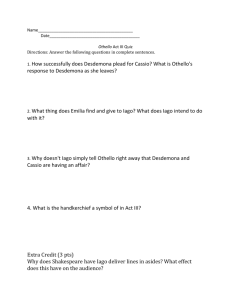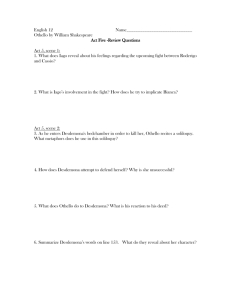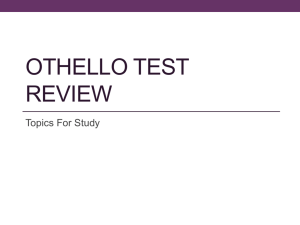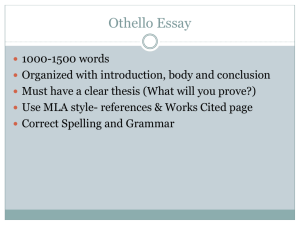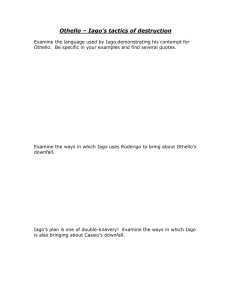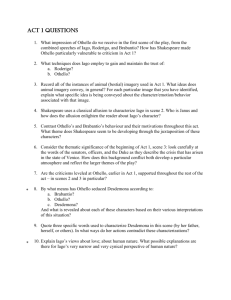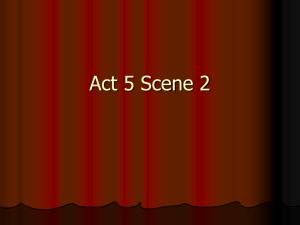Othello Content Questions
advertisement
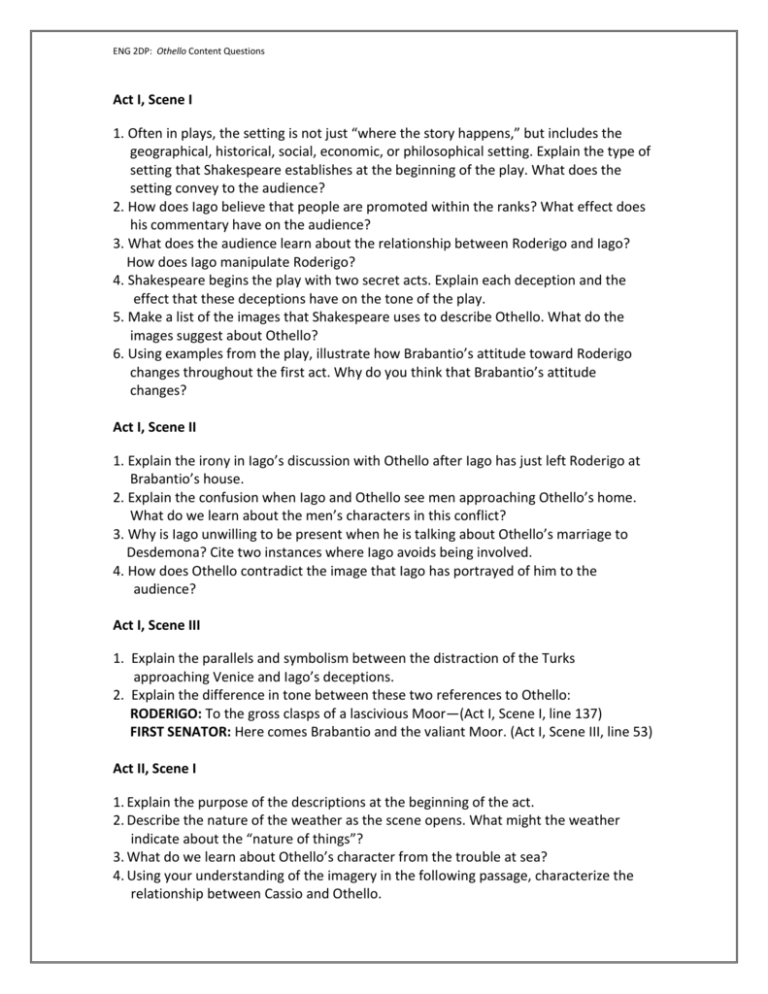
ENG 2DP: Othello Content Questions Act I, Scene I 1. Often in plays, the setting is not just “where the story happens,” but includes the geographical, historical, social, economic, or philosophical setting. Explain the type of setting that Shakespeare establishes at the beginning of the play. What does the setting convey to the audience? 2. How does Iago believe that people are promoted within the ranks? What effect does his commentary have on the audience? 3. What does the audience learn about the relationship between Roderigo and Iago? How does Iago manipulate Roderigo? 4. Shakespeare begins the play with two secret acts. Explain each deception and the effect that these deceptions have on the tone of the play. 5. Make a list of the images that Shakespeare uses to describe Othello. What do the images suggest about Othello? 6. Using examples from the play, illustrate how Brabantio’s attitude toward Roderigo changes throughout the first act. Why do you think that Brabantio’s attitude changes? Act I, Scene II 1. Explain the irony in Iago’s discussion with Othello after Iago has just left Roderigo at Brabantio’s house. 2. Explain the confusion when Iago and Othello see men approaching Othello’s home. What do we learn about the men’s characters in this conflict? 3. Why is Iago unwilling to be present when he is talking about Othello’s marriage to Desdemona? Cite two instances where Iago avoids being involved. 4. How does Othello contradict the image that Iago has portrayed of him to the audience? Act I, Scene III 1. Explain the parallels and symbolism between the distraction of the Turks approaching Venice and Iago’s deceptions. 2. Explain the difference in tone between these two references to Othello: RODERIGO: To the gross clasps of a lascivious Moor—(Act I, Scene I, line 137) FIRST SENATOR: Here comes Brabantio and the valiant Moor. (Act I, Scene III, line 53) Act II, Scene I 1. Explain the purpose of the descriptions at the beginning of the act. 2. Describe the nature of the weather as the scene opens. What might the weather indicate about the “nature of things”? 3. What do we learn about Othello’s character from the trouble at sea? 4. Using your understanding of the imagery in the following passage, characterize the relationship between Cassio and Othello. ENG 2DP: Othello Content Questions CASSIO: His bark is stoutly timber’d, and his pilot Of very expert and approved allowance; Therefore my hopes, not surfeited to death, Stand in bold cure. (lines 53 – 56) 5. Early in Scene I, as Iago and Desdemona’s ship approaches, Cassio describes Desdemona to the Gentlemen with whom he is speaking: CASSIO: Most fortunately: he hath achieved a maid That paragons1 description and wild fame; / One that excels the quirks2 of blazoning pens, / And in the essential vesture3 of creation / Does tire the ingener.4 and later refers to Desdemona as “the riches of the ship” (line 91). 1 outdoes 2 figures of speech 3 clothing (i.e., her natural traits) 4 one who might describe her Reread Iago’s description of women as he characterizes them in lines 115 – 177. Contrast the two descriptions of women. Why does Shakespeare include both of the descriptions? What do the commentaries tell us about the person making the assertions? 6. After the interchange between Desdemona and Iago, how would you characterize Desdemona? 7. What is the purpose of the following aside? IAGO: (Aside.) He takes her by the palm; ay, well said, whisper. / With as little a web as this will I ensnare as great a fly as Cassio. / Ay, smile upon her, do; I will gyve5 thee in thine own courtship. / You say true; ‘tis so, indeed. / If such tricks as these strip you out of your lieutenantry, it had been better you had not kissed your three fingers so often which now again you are most apt to play the sir6 in. / Very good. Well kissed! an excellent courtesy! ‘tis so, indeed. Yet again your fingers to your lips? Would they were clysterpipes7 for your sake! [Trumpet within.] The Moor! I know his trumpet. (1.1.180 – 185) 8. Read the following section and explain how it functions as an example of foreshadowing: OTHELLO: ...If it were now to die, / Twere now to be most happy; for I fear / My soul hath her content so absolute / That not another comfort like to this / Succeeds in unknown fate. (Act II, Scene I, lines 202 – 206) 9. What does Othello mean when he states, “News friends: our wars are done, the Turks are drown’d.” (Act II, Scene I, line 219) 10. Why do Iago and Roderigo stay behind after all the others have left to travel to Cyprus? What is further revealed about Iago’s plan? How does Roderigo respond to Iago’s claims? 11. What does Iago instruct Roderigo to do? 12. Read the soliloquy that ends the scene. What does the reader learn about Iago’s plan? What are the possible motivations for Iago’s revenge? What do you believe is the reason for Iago’s anger at Cassio and Othello? ENG 2DP: Othello Content Questions Act II, Scene II 1. Explain the occasion on which the Herald is giving his proclamation. Summarize the Herald’s proclamation. Act II, Scene III 1. On what occasion are Iago and Cassio going to spend time together? Explain the dramatic irony in the situation and in Othello’s statement, “Iago is most honest.” (2.3.7) 2. Read the first 42 lines of Act II, Scene III again. Using examples from the text, explain the differences between how Othello speaks about and to Desdemona and how Cassio and Iago discuss the current “situation” between Othello and Desdemona. What might these speeches tell the audience about the characters of the men? 3. Analyze the conversation between Iago and Cassio in lines 13 – 41 in Act II, Scene III. What do you believe Iago is trying to accomplish? 4. When Iago learns that his plan to influence Cassio’s feelings about Desdemona has failed, what does he try to do? Analyze Iago’s speech and explain Iago’s purpose in his actions. IAGO: If I can fasten but one cup upon him, With that which he hath drunk tonight already, He’ll be as full of quarrel and offense As my young mistress’ dog. Now my sick fool Roderigo, Whom love hath turn’d almost the wrong side out, To Desdemona hath tonight caroused Potations pottledeep;8 and he’s to watch: Three lads of Cyprus, noble swelling spirits, That hold their honors in a wary distance,9 The very elements of this warlike isle, Have I tonight fluster’d with flowing cups, And they watch too. Now, ‘mongst this flock of drunkards, Am I to put our Cassio in some action10 That may offend the isle. But here they come: If consequence11 do but approve12 my dream,13 My boat sails freely, both with wind and stream. (2.3. 42 – 58) 5. Explain the significance of the following line by first explaining the speaker, the audience, and the situation in which the line is contextualized. “He is a soldier fit to stand by Caesar and give direction.” 6. Summarize what happens after Cassio and Iago drink with the men. 7. Trace the use of the word “honest” through Act II. Explain the irony in how it is used in lines 132 – 133. 8. Explain Othello’s insinuation when he states, “Are we turn’s Turks, and to ourselves do that which heaven hath forbid the Ottomites?” (Act II, Scene III, lines 162 – 164) 9. Why do you think the men will not answer Othello’s questions about what happened between the men? 10. When Iago is explaining to Othello what happened to cause the fight, why do you think he leaves Roderigo’s name out of the narration? 11. What action does Othello take against Cassio upon hearing that Cassio is responsible for the fight? ENG 2DP: Othello Content Questions 12. Describe the relationship between Desdemona and Othello as it appears at this point in the play. 13. Explain the difference between the way Cassio and Iago view reputations. Is the view of reputation that Iago explains to Cassio an accurate depiction of how he really feels? How do we know? 14. How does Cassio misunderstand the “devil” in the situation? 15. Explain the imagery in Iago’s soliloquy. What do we learn about Iago’s character through this speech? What do we learn about his plan? IAGO: And what’s he then that says I play the villain? . . . That shall enmesh them all. (Act II, Scene III, lines 321 – 347) 16. At this point in the play, we must investigate the motivation behind Iago’s scheme in order to understand Iago’s strategies and how his plan to destroy Othello is put into place. You may need to refer to previous scenes in the play. a. What do you believe is Iago’s motivation in his destruction of Othello? b. How does Iago immediately ensnare Roderigo as an accomplice in his plan? c. Examine the conversations between Iago and Othello throughout the play thus far. What technique does Iago use in speaking to Othello that helps to advance his plan? d. Reread Iago’s last three speeches at the end of Act One. What does it appear is his motivation for his hatred of Othello? Find an example from the text to support your answer. e. Explain the Cassio phase of Iago’s plan to dishonor, discredit, and destroy Othello. 17. Examine Iago’s language at the end of Act Two. How does the language change? What might have been a reason for Shakespeare to employ this change at the end of the act? Act III, Scene I 1. Explain the action and purpose at the beginning of the scene. 2. How is the concept of honesty contrasted in the conversation between Iago and Cassio? 3. What request does Cassio make of Emilia? Act III, Scene II 1. Summarize the events in this scene. Act III, Scene III 1. What is significant about the action at the beginning of the scene? What do we learn about the conversation between Desdemona and Cassio? 2. Explain the foreshadowing in the following lines: ENG 2DP: Othello Content Questions CASSIO: Ay, but, lady, / That policy may either last so long, / Or feed upon such nice and waterish diet, / Or breed itself so out of circumstance, / That, I being absent and my place supplied, / My general will forget my love and service. (3. 3. 15 – 20) 3. How does Iago take advantage of Cassio’s departure as soon as Othello enters the garden? 4. Explain the irony in Desdemona’s statement “I have no judgement in an honest face ....” (3.3.54) 5. Explain Desdemona’s tone in her conversation with Othello concerning Cassio. 6. After Desdemona compels Othello to speak to Cassio, she leaves. Othello states the following: OTHELLO: Excellent wretch! / Perdition catch my soul, / But I do love thee! and when I love thee not, / Chaos is come again. (3. 3. 100 – 103) Why do you think Iago is able to sow the seed of jealousy in Othello’s heart, if Othello loves Desdemona as much as he claims he does? How does Iago influence Othello’s thoughts? 7. Explain the meaning in Othello’s speech: OTHELLO: Why, why is this? . . . Away at once with love or jealousy! (3.3.199 – 215) 8. What does the image of the “green-eyed monster” signify, and how is it represented as a theme throughout the play? Read the following lines and explain the irony. IAGO: O, beware, my lord, of jealousy! / It is the green-eyes monster, which doth mock / The meat it feeds on. (3. 3. 165 – 167) 9. Read the following speech. How does Iago use Othello’s personality as a part of his plan to ruin the Moor? What advice does he give Othello? IAGO: I am glad of it; for now I shall have reason . . . Is not to leave’t undone, but keep’t unknown. (3. 3. 216 – 227) 10. What does Iago reveal about his character in his interaction with Othello? 11. Read the following lines from Act Three. How does Othello compare himself with Desdemona? What do we learn about Othello’s view of himself and Iago? OTHELLO: This fellow’s of exceeding honesty, / And knows all qualities, with a learned spirit, / Of human dealings. . . Even then this forked plague is fated to us When we do quicken. Desdemona comes .... (3. 3. 289 – 308) 12. Desdemona’s handkerchief becomes an important piece of stage business. Why did Desdemona produce it? What happens to it? What does Emilia plan to do with it? Finally, who gets it, and what is to be done with it? 13. How would you characterize the relationship between Iago and Emilia? 14. Iago’s first step in his plan to dishonor Othello is to ruin the Moor’s opinion of ENG 2DP: Othello Content Questions Cassio. That being accomplished, Iago then attempts to make Othello jealous. Again, with only so much as a word, Iago is able to accomplish the task. After he retrieves the handkerchief from Emilia, how does he prompt Othello to discuss the proof again? 15. Why do you think Othello is willing to believe Iago without confronting his wife with the accusation? What do you believe Shakespeare is saying about the relationships between men and women during this time? 16. Analyze Iago’s view of love as is illustrated in his following statement: It is impossible you should see this Were they as prime as goats, as hot as monkeys, As salt as wolves in pride, and fools as gross As ignorance made drunk. (3. 3. 448 – 451) 17. As Iago continues to fuel Othello’s mistrust, Othello begins to respond to Iago’s insinuations in short bursts of speech. Analyze Act III, Scene III, lines 373 – 530 and draw a conclusion about Othello’s state of mind. Answers the following questions: a. Which of the lines illustrate Othello’s emotional confusion between rationally analyzing the situation between Desdemona and Cassio and doubting Desdemona’s love and fidelity? b. Which of the lines illustrate Iago’s ability to turn Othello into the “green-eyed monster”? c. Which of the linesi llustrate Othello’s weaknesses that allow him to fall into Iago’s trap? . 18. At the end of Act III, Scene III, Othello makes a request. What does he ask of Iago? What becomes of Iago? Act III, Scene IV 1. Explain how the scene’s beginning is in direct contrast to the end of the previous scene. 2. What do you believe is the symbolism associated with the handkerchief? 3. Othello and Desdemona see each other for the first time since Iago has poisoned Othello’s mind. How does Othello seem to be treating Desdemona? What language gives away the complexity behind Othello’s emotions? 4. Explain the significance of the following speech. OTHELLO: This argues fruitfulness and liberal heart: . . . ‘Tis a good hand, / A frank one. (3.4. 39 – 45) 5. After Othello describes the importance of the handkerchief (lines 60 – 73), he tries to elicit a response from Desdemona about where she may find the handkerchief. Evaluate the language between Desdemona and Othello. What do you notice about Othello’s demeanor as it is illustrated through his language? 6. How does Desdemona interpret Othello’s questions in lines 75 – 107? 7. What do you believe is the central conflict at this point in the play? What do you believe will be Iago’s further role in the conflict? 8. Explain the symbolism in the following lines: ENG 2DP: Othello Content Questions EMILIA: But jealous souls will not be answer’d so; They are not ever jealous for the cause, But jealous for they are jealous. ‘Tis a monster Begot upon itself, born on itself. (3. 4. 169 – 172) Explain the connection and the irony between Iago’s earlier reference to the greeneyed monster and Emilia’s reference to the monster above. 9. A foil is a character who contrasts or parallels a main character in a play or story. Some people characterize Emilia and Bianca as foil for Desdemona. How would you explain Emilia as a foil for Desdemona? 10. In the final scene of Act III, Bianca is angry at Cassio. How do Bianca and Othello parallel each other in their relationships with their significant others? 11. In this scene, Othello recounts the way in which he came to have the handkerchief that Desdemona has lost. What does Othello’s speech highlight about his character? How does this play into Iago’s manipulation of the scenario between Othello, Cassio, and Desdemona? Cite an example from the play that illustrates Iago’s use of Othello’s perceived weakness. Act IV, Scene I 1. How does the scene begin? Explain the significance of the following conversation between Iago and Othello. Explain the symbolism of the handkerchief. IAGO: So they do nothing, ‘tis a venial30 slip: / But if I give my wife a handkerchief OTHELLO: What then? IAGO: Why, then, ‘tis hers, my lord, and being hers, / She may, I think, bestow’t on any man. OTHELLO: She is protectress of her honour too: May she give that? IAGO: Her honour is an essence that’s not seen; / They have it very oft that have it not: But, for the handkerchief— OTHELLO: By heaven, I would most gladly have forgot it: / Thou said’st—it comeso’er my memory, / As doth the raven31 o’er the infected house, / Boding to all—he had my handkerchief. 2. What physical reactions does Othello have to the news about Desdemona and Cassio? How might the audience interpret this response? 3. How does Othello misinterpret the dialogue between Cassio and Iago? How might an observant person realize that Cassio is speaking of Bianca rather than Desdemona? 4. With what does Othello charge Iago? How does Iago further influence Othello as they discuss Cassio’s and Desdemona’s murders? 5. How has Desdemona and Othello’s relationship changed since the beginning of the ENG 2DP: Othello Content Questions play? 6. Who is Lodovico? Explain what his presence in the play highlight about Othello’s character. 7. Explain the events as they transpire when Lodovico arrives. What do the events illustrate about Othello’s transformation? Cite a textual example that supports this recognized change in Othello’s behavior. How does this contribute to Othello’s ultimate demise? 8. Explain the irony in the following speech. How does Shakespeare continue to highlight the theme of appearance versus reality? IAGO: Alas, alas! It is not honesty in me to speak What I have seen and known. You shall observe him, And his own courses will denote him so That I may save my speech: do but go after, And mark how he continues. LODOVICO: I am sorry that I am deceived in him. (Act IV, Scene I, lines 299 – 305) 9. Pay attention to Othello’s language in this scene. How does his use of language parallel his language in Act III? What does Othello’s use of language explain about his character? Act IV, Scene II 1. How does Emilia prove to be a friend to Desdemona? How does her characterization of the cause of Othello’s mistrust parallel Emilia’s beliefs about men and marriage? 2. In the following speech, to what does “it” refer? EMILIA: I durst, my lord, to wager she is honest, / Lay down my soul at stake. / If you think other, / Remove your thought; it doth abuse your bosom. If any wretch have put this in your head, / Let heaven requite it with the serpent’s curse! / For, if she be not honest, chaste, and true, / There’s no man happy; the purest of their wives Is foul as slander. (4. 2. 14 – 21) 3. Explain the rhetorical strategy that Shakespeare uses in the following passage. What is its effect? OTHELLO: Was this fair paper, this most goodly book, . . . What committed! / Impudent strumpet! (4. 2. 79 – 89) 4. Read the following interchange between Iago, Desdemona, and Emilia. What question does Desdemona ask of Iago? How does he initially respond? What does this say about his character? IAGO: What’s the matter, lady? ... IAGO: Fie, there is no such man; it is impossible. (4. 2. 130 – 152) 5. Roderigo is absent throughout much of the play. Explain Roderigo’s influence in the action in the play despite his invisibility. How is this a testimony to Iago’s manipulation? What is Roderigo’s purpose in this scene? 6. What exposition are we given through the conversation between Iago and Roderigo? ENG 2DP: Othello Content Questions What is Roderigo able to learn about Iago’s character that the other characters in the play have not? 7. How does Iago manipulate Roderigo at the end of Scene Two? How do we know that Iago is manipulating Roderigo? Act IV, Scene III 1. Explain the meaning of Emilia’s statement, “I would you had never seen him!” (Act IV, Scene III, line 19) What is the context in which she makes the statement? How does Desdemona respond to Emilia’s statement, and what does this illustrate about Desdemona’s character? 2. Shakespeare uses foreshadowing in this final scene of Act Four to show what is going to happen to Desdemona. Cite several examples of foreshadowing in the scene and explain what they imply about Desdemona’s knowledge of her death. 3. Explain the purpose of the final conversation between Emilia and Desdemona. Of what do the two women speak? 4. Read Emilia’s final speech in Act Four. What comment do you believe Shakespeare might be trying to make about the relationships between men and women through Emilia’s speech at the end of Act Four? How does Emilia’s speech contrast Desdemona’s beliefs about the relationships between men and women during the Renaissance? EMILIA: Yes, a dozen, and as many to the vantage as would store the world they played for. . . Then let them use us well; else let them know, The ills we do, their ills instruct us so. (4.389 – 108) Act V, Scene I 1. Explain what the following speech illustrates about Iago’s character. IAGO: I have rubb’d this young quat almost to the sense,/ And he grows angry. . . 2. 3. 4. 5. 6. 7. 8. No, he must die. But so: I hear him coming. (5. 1. 11 – 21) For what two reasons does Iago say he wants Cassio dead? In the battle, who is responsible for the wounds? Explain Othello’s reaction to Roderigo’s and Casio’s injuries. With what does he give Iago credit? Explain the irony in Othello’s words. OTHELLO: ‘Tis he. O brave Iago, honest and just, / That hast such noble sense of thy friend’s wrong! / Thou teachest me. Minion, your dear lies dead, / And your unblest fate hies. Strumpet, I come! / Forth of my heart those charms, thine eyes, are blotted; / Thy bed, lust-stain’d, shall with lust’s blood be spotted. (5.1.32 – 37) How is Iago able to manipulate the situation even further? How does his manipulation of the scene connect to the theme of the play? Why does Roderigo say to Iago, “O, damn’d Iago! O inhuman dog!”? Explain Iago’s implication of Bianca. Explain why you believe he chooses to implicate her. Read the following speech, paying particular attention to the aside. What does Iago’s ENG 2DP: Othello Content Questions statement lead us to believe about him? IAGO: Kind gentlemen, let’s go see poor Cassio dress’d. . . . That either makes me or fordoes me quite. (5.1. 138 – 143) Act V, Scene II 1. Read Othello’s speech at the beginning of scene. Explain Othello’s state of mind. How does his use of language compare with his use of language in Act Four? As he contemplates murdering Desdemona, with what does he compare taking her life? Explain the uses of diction as Shakespeare employs them in this speech. OTHELLO: It is the cause, it is the cause, my soul. . . It strikes where it doth love. She wakes. (5. 2. 1 – 22) 2. Why does Othello ask Desdemona if she prayed before she went to sleep? 3. How does Desdemona try to convince Othello not to kill her? What is the effect of her final conversation with Othello? 4. Explain the symbolism and recognition of the handkerchief in this final scene. 5. When Othello tells Desdemona of Cassio’s death, what is her reaction? How does Othello interpret this reaction? 6. Othello believes that he has killed Desdemona. Explain his reaction to her death. OTHELLO: Yes: ‘tis Emilia. By and by. She’s dead. ‘. . . Should yawn at alteration. (5.2. 110 – 120) 7. Explain the events in the following lines from Act Five. Why does Desdemona say what she says? EMILIA: Alas, what cry is that? OTHELLO: That? what? EMILIA: Out, and alas! That was my lady’s voice. Help! help, ho! help! O lady, speak again! Sweet Desdemona! O sweet mistress, speak! DESDEMONA: A guiltless death I die. EMILIA: O, who hath done this deed? DESDEMONA: Nobody; I myself. Farewell; Commend me to my kind lord. O, farewell! [Dies] (5. 2. 141 – 149) 8. Why does Emilia repeat the phrase, “My husband!” three times? 9. How does Shakespeare reveal Iago’s duplicity after Desdemona’s murder? 10. How is Emilia’s fate parallel to Desdemona’s? 11. What is the implication behind Gratiano’s speech? GRATIANO: Poor Desdemona! I am glad thy father’s dead: / Thy match was mortal To him, and pure grief / Shore his old thread in twain; did he live now, / This sight would make him do a desperate turn, / Yea, curse his better angel from his side, / And fall to reprobation. 12. Explain the irony in Iago’s statement. IAGO: Demand me nothing: what you know, you know: From this time forth I never will speak word. (5.2.348 – 349) 13. How does darkness function in the scene? 14. Explain the imagery in Othello’s final speech. What is he requesting? How does the imagery speak to Othello’s character? ENG 2DP: Othello Content Questions OTHELLO: Soft you; a word or two before you go. . . And smote him, thus. (5.2388 – 406)
